A Report on Socio-Economic and Legal Environment on Uber: Analysis
VerifiedAdded on 2022/08/24
|19
|6198
|17
Report
AI Summary
This report provides a comprehensive analysis of Uber's socio-economic and legal environment. It examines Uber's disruptive impact on the taxi industry, highlighting its business model based on the sharing economy and its influence on traditional taxi services. The report delves into the technological factors, such as smartphones, GPS, and the internet, that have supported Uber's growth. It assesses the benefits for both riders and drivers while acknowledging potential disadvantages, including monopoly concerns and labor market pressures. Furthermore, the report explores the legal and political factors impacting Uber's operations, offering recommendations for governmental policies and antitrust laws to mitigate potential negative consequences. The report concludes by emphasizing the significant benefits Uber brings to the economy and suggests adjustments to its pricing policies to ensure its continued success.
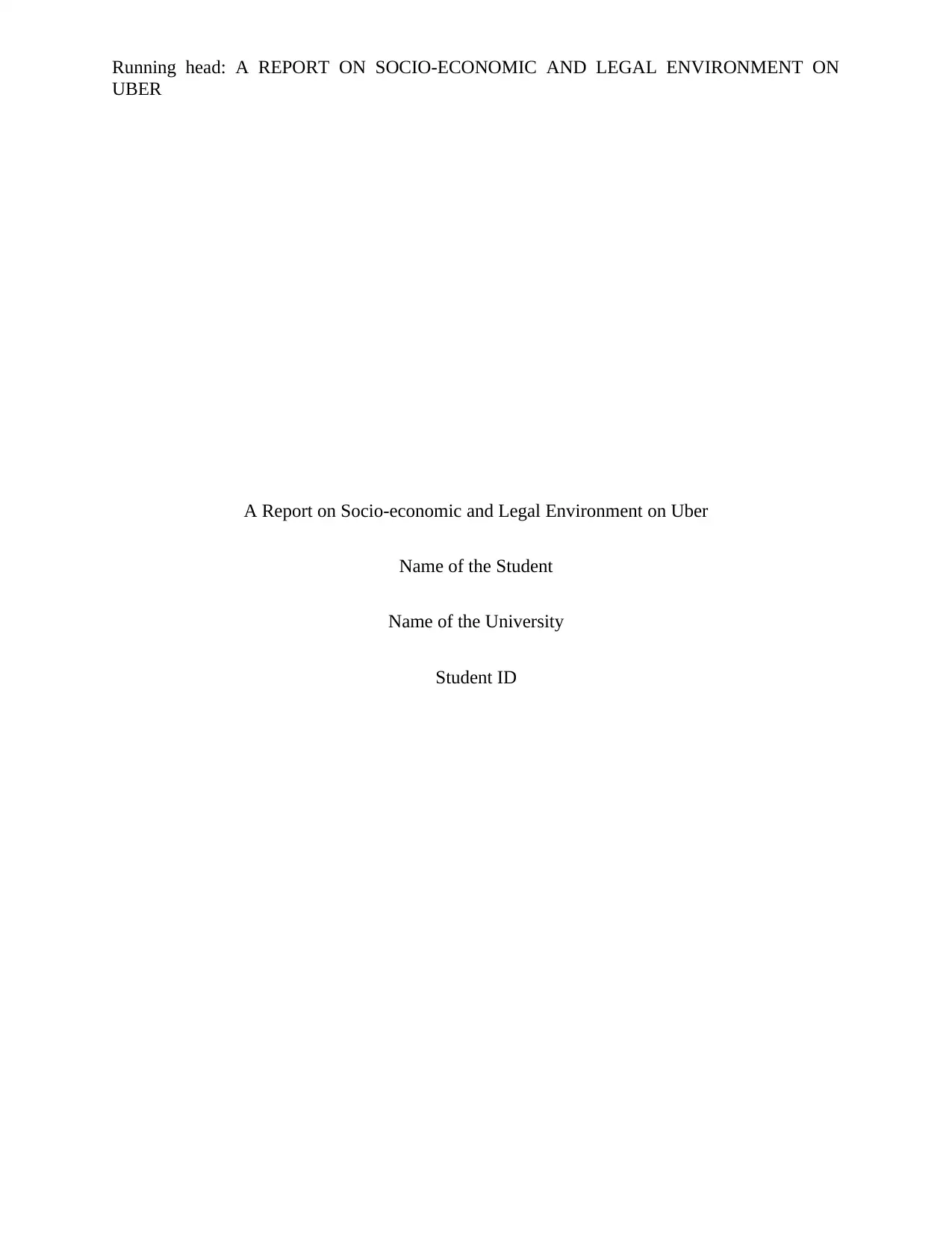
Running head: A REPORT ON SOCIO-ECONOMIC AND LEGAL ENVIRONMENT ON
UBER
A Report on Socio-economic and Legal Environment on Uber
Name of the Student
Name of the University
Student ID
UBER
A Report on Socio-economic and Legal Environment on Uber
Name of the Student
Name of the University
Student ID
Paraphrase This Document
Need a fresh take? Get an instant paraphrase of this document with our AI Paraphraser
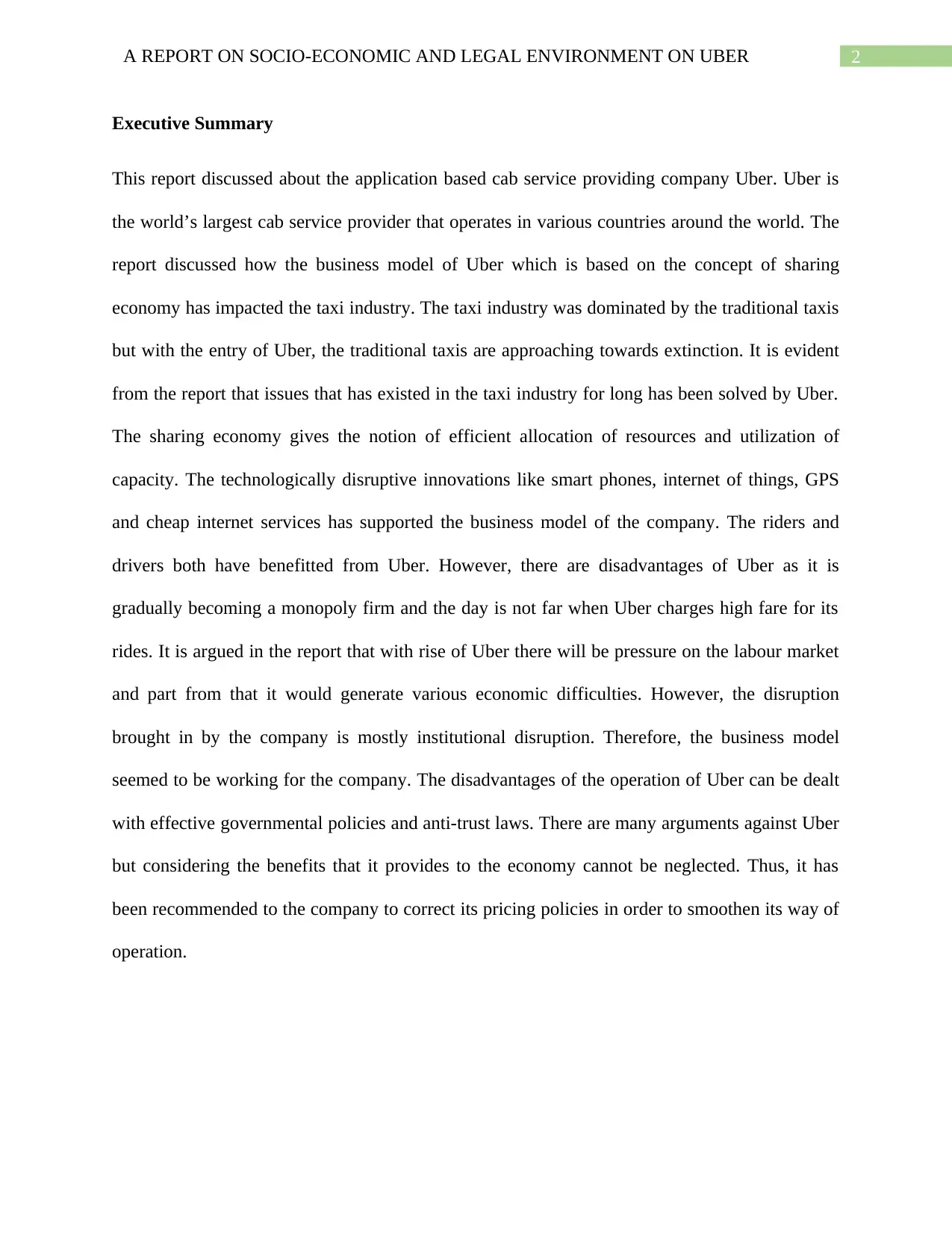
2A REPORT ON SOCIO-ECONOMIC AND LEGAL ENVIRONMENT ON UBER
Executive Summary
This report discussed about the application based cab service providing company Uber. Uber is
the world’s largest cab service provider that operates in various countries around the world. The
report discussed how the business model of Uber which is based on the concept of sharing
economy has impacted the taxi industry. The taxi industry was dominated by the traditional taxis
but with the entry of Uber, the traditional taxis are approaching towards extinction. It is evident
from the report that issues that has existed in the taxi industry for long has been solved by Uber.
The sharing economy gives the notion of efficient allocation of resources and utilization of
capacity. The technologically disruptive innovations like smart phones, internet of things, GPS
and cheap internet services has supported the business model of the company. The riders and
drivers both have benefitted from Uber. However, there are disadvantages of Uber as it is
gradually becoming a monopoly firm and the day is not far when Uber charges high fare for its
rides. It is argued in the report that with rise of Uber there will be pressure on the labour market
and part from that it would generate various economic difficulties. However, the disruption
brought in by the company is mostly institutional disruption. Therefore, the business model
seemed to be working for the company. The disadvantages of the operation of Uber can be dealt
with effective governmental policies and anti-trust laws. There are many arguments against Uber
but considering the benefits that it provides to the economy cannot be neglected. Thus, it has
been recommended to the company to correct its pricing policies in order to smoothen its way of
operation.
Executive Summary
This report discussed about the application based cab service providing company Uber. Uber is
the world’s largest cab service provider that operates in various countries around the world. The
report discussed how the business model of Uber which is based on the concept of sharing
economy has impacted the taxi industry. The taxi industry was dominated by the traditional taxis
but with the entry of Uber, the traditional taxis are approaching towards extinction. It is evident
from the report that issues that has existed in the taxi industry for long has been solved by Uber.
The sharing economy gives the notion of efficient allocation of resources and utilization of
capacity. The technologically disruptive innovations like smart phones, internet of things, GPS
and cheap internet services has supported the business model of the company. The riders and
drivers both have benefitted from Uber. However, there are disadvantages of Uber as it is
gradually becoming a monopoly firm and the day is not far when Uber charges high fare for its
rides. It is argued in the report that with rise of Uber there will be pressure on the labour market
and part from that it would generate various economic difficulties. However, the disruption
brought in by the company is mostly institutional disruption. Therefore, the business model
seemed to be working for the company. The disadvantages of the operation of Uber can be dealt
with effective governmental policies and anti-trust laws. There are many arguments against Uber
but considering the benefits that it provides to the economy cannot be neglected. Thus, it has
been recommended to the company to correct its pricing policies in order to smoothen its way of
operation.
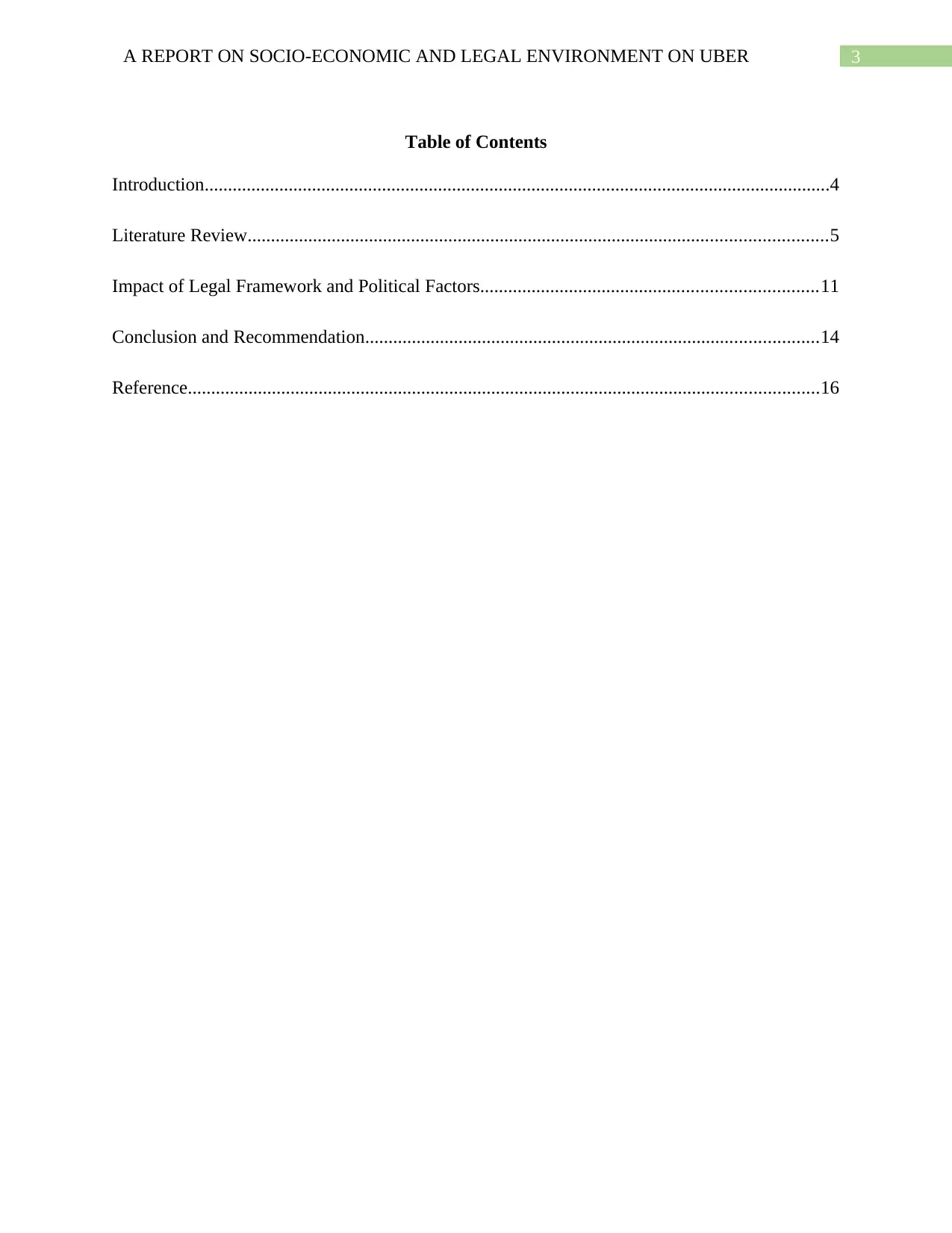
3A REPORT ON SOCIO-ECONOMIC AND LEGAL ENVIRONMENT ON UBER
Table of Contents
Introduction......................................................................................................................................4
Literature Review............................................................................................................................5
Impact of Legal Framework and Political Factors........................................................................11
Conclusion and Recommendation.................................................................................................14
Reference.......................................................................................................................................16
Table of Contents
Introduction......................................................................................................................................4
Literature Review............................................................................................................................5
Impact of Legal Framework and Political Factors........................................................................11
Conclusion and Recommendation.................................................................................................14
Reference.......................................................................................................................................16
⊘ This is a preview!⊘
Do you want full access?
Subscribe today to unlock all pages.

Trusted by 1+ million students worldwide
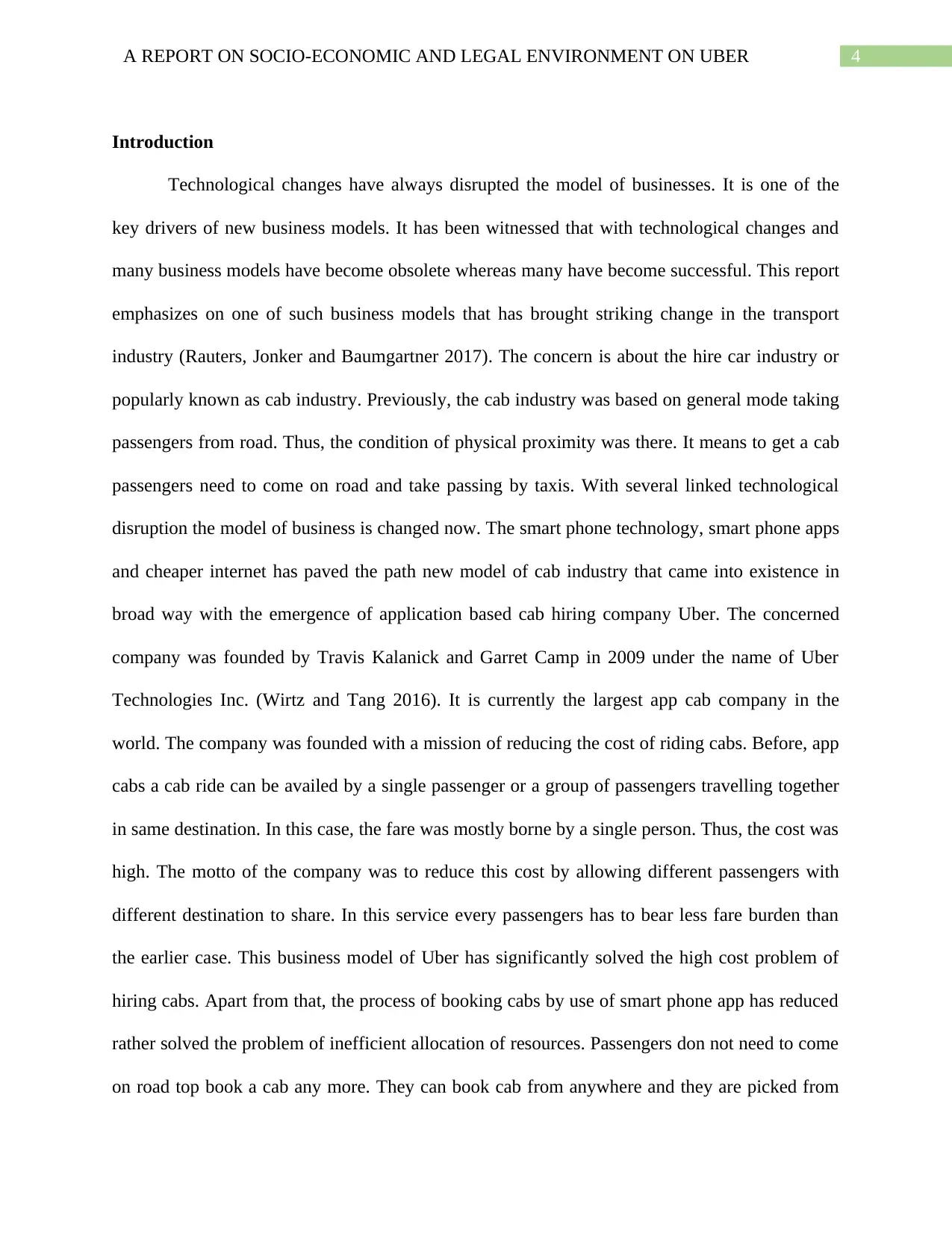
4A REPORT ON SOCIO-ECONOMIC AND LEGAL ENVIRONMENT ON UBER
Introduction
Technological changes have always disrupted the model of businesses. It is one of the
key drivers of new business models. It has been witnessed that with technological changes and
many business models have become obsolete whereas many have become successful. This report
emphasizes on one of such business models that has brought striking change in the transport
industry (Rauters, Jonker and Baumgartner 2017). The concern is about the hire car industry or
popularly known as cab industry. Previously, the cab industry was based on general mode taking
passengers from road. Thus, the condition of physical proximity was there. It means to get a cab
passengers need to come on road and take passing by taxis. With several linked technological
disruption the model of business is changed now. The smart phone technology, smart phone apps
and cheaper internet has paved the path new model of cab industry that came into existence in
broad way with the emergence of application based cab hiring company Uber. The concerned
company was founded by Travis Kalanick and Garret Camp in 2009 under the name of Uber
Technologies Inc. (Wirtz and Tang 2016). It is currently the largest app cab company in the
world. The company was founded with a mission of reducing the cost of riding cabs. Before, app
cabs a cab ride can be availed by a single passenger or a group of passengers travelling together
in same destination. In this case, the fare was mostly borne by a single person. Thus, the cost was
high. The motto of the company was to reduce this cost by allowing different passengers with
different destination to share. In this service every passengers has to bear less fare burden than
the earlier case. This business model of Uber has significantly solved the high cost problem of
hiring cabs. Apart from that, the process of booking cabs by use of smart phone app has reduced
rather solved the problem of inefficient allocation of resources. Passengers don not need to come
on road top book a cab any more. They can book cab from anywhere and they are picked from
Introduction
Technological changes have always disrupted the model of businesses. It is one of the
key drivers of new business models. It has been witnessed that with technological changes and
many business models have become obsolete whereas many have become successful. This report
emphasizes on one of such business models that has brought striking change in the transport
industry (Rauters, Jonker and Baumgartner 2017). The concern is about the hire car industry or
popularly known as cab industry. Previously, the cab industry was based on general mode taking
passengers from road. Thus, the condition of physical proximity was there. It means to get a cab
passengers need to come on road and take passing by taxis. With several linked technological
disruption the model of business is changed now. The smart phone technology, smart phone apps
and cheaper internet has paved the path new model of cab industry that came into existence in
broad way with the emergence of application based cab hiring company Uber. The concerned
company was founded by Travis Kalanick and Garret Camp in 2009 under the name of Uber
Technologies Inc. (Wirtz and Tang 2016). It is currently the largest app cab company in the
world. The company was founded with a mission of reducing the cost of riding cabs. Before, app
cabs a cab ride can be availed by a single passenger or a group of passengers travelling together
in same destination. In this case, the fare was mostly borne by a single person. Thus, the cost was
high. The motto of the company was to reduce this cost by allowing different passengers with
different destination to share. In this service every passengers has to bear less fare burden than
the earlier case. This business model of Uber has significantly solved the high cost problem of
hiring cabs. Apart from that, the process of booking cabs by use of smart phone app has reduced
rather solved the problem of inefficient allocation of resources. Passengers don not need to come
on road top book a cab any more. They can book cab from anywhere and they are picked from
Paraphrase This Document
Need a fresh take? Get an instant paraphrase of this document with our AI Paraphraser
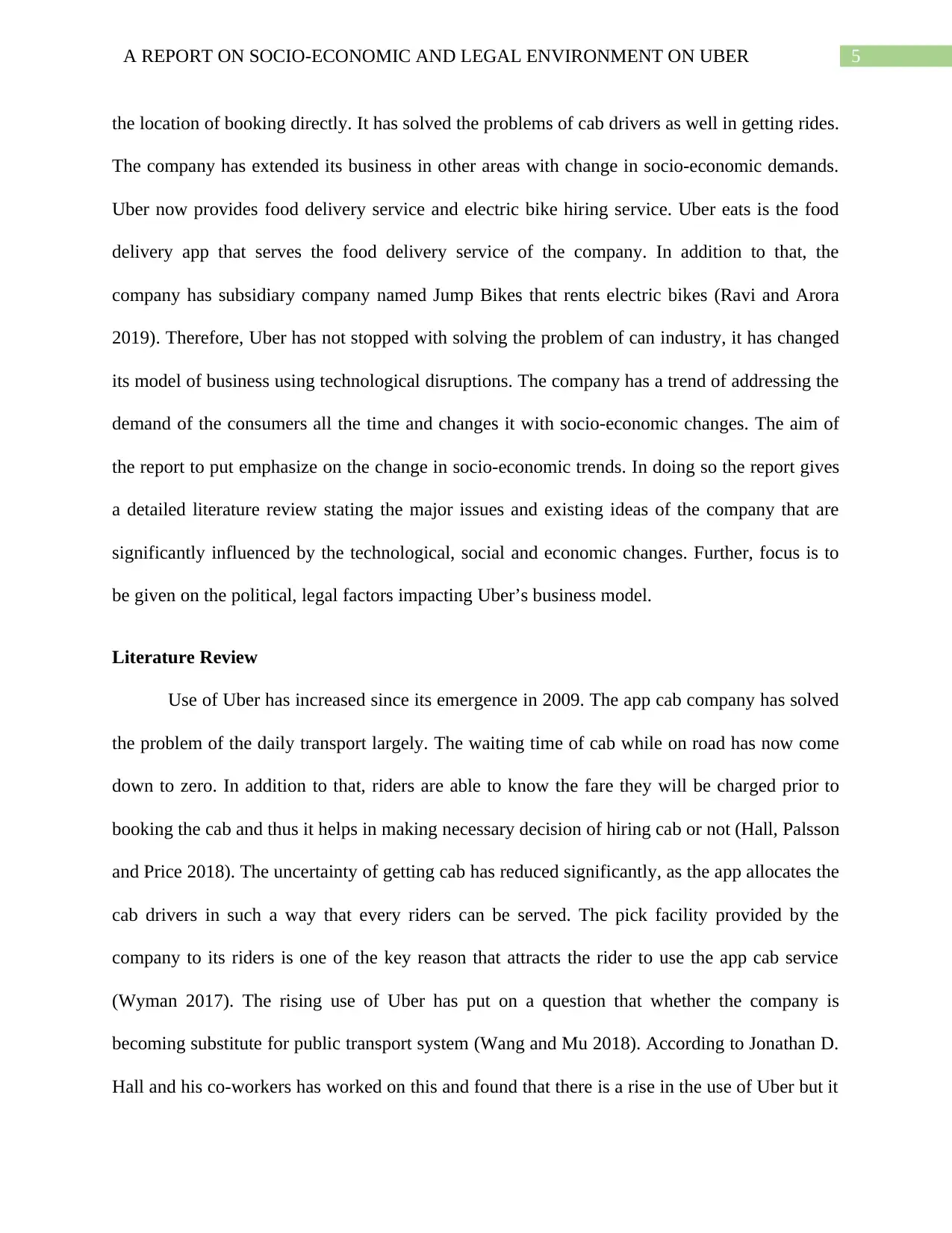
5A REPORT ON SOCIO-ECONOMIC AND LEGAL ENVIRONMENT ON UBER
the location of booking directly. It has solved the problems of cab drivers as well in getting rides.
The company has extended its business in other areas with change in socio-economic demands.
Uber now provides food delivery service and electric bike hiring service. Uber eats is the food
delivery app that serves the food delivery service of the company. In addition to that, the
company has subsidiary company named Jump Bikes that rents electric bikes (Ravi and Arora
2019). Therefore, Uber has not stopped with solving the problem of can industry, it has changed
its model of business using technological disruptions. The company has a trend of addressing the
demand of the consumers all the time and changes it with socio-economic changes. The aim of
the report to put emphasize on the change in socio-economic trends. In doing so the report gives
a detailed literature review stating the major issues and existing ideas of the company that are
significantly influenced by the technological, social and economic changes. Further, focus is to
be given on the political, legal factors impacting Uber’s business model.
Literature Review
Use of Uber has increased since its emergence in 2009. The app cab company has solved
the problem of the daily transport largely. The waiting time of cab while on road has now come
down to zero. In addition to that, riders are able to know the fare they will be charged prior to
booking the cab and thus it helps in making necessary decision of hiring cab or not (Hall, Palsson
and Price 2018). The uncertainty of getting cab has reduced significantly, as the app allocates the
cab drivers in such a way that every riders can be served. The pick facility provided by the
company to its riders is one of the key reason that attracts the rider to use the app cab service
(Wyman 2017). The rising use of Uber has put on a question that whether the company is
becoming substitute for public transport system (Wang and Mu 2018). According to Jonathan D.
Hall and his co-workers has worked on this and found that there is a rise in the use of Uber but it
the location of booking directly. It has solved the problems of cab drivers as well in getting rides.
The company has extended its business in other areas with change in socio-economic demands.
Uber now provides food delivery service and electric bike hiring service. Uber eats is the food
delivery app that serves the food delivery service of the company. In addition to that, the
company has subsidiary company named Jump Bikes that rents electric bikes (Ravi and Arora
2019). Therefore, Uber has not stopped with solving the problem of can industry, it has changed
its model of business using technological disruptions. The company has a trend of addressing the
demand of the consumers all the time and changes it with socio-economic changes. The aim of
the report to put emphasize on the change in socio-economic trends. In doing so the report gives
a detailed literature review stating the major issues and existing ideas of the company that are
significantly influenced by the technological, social and economic changes. Further, focus is to
be given on the political, legal factors impacting Uber’s business model.
Literature Review
Use of Uber has increased since its emergence in 2009. The app cab company has solved
the problem of the daily transport largely. The waiting time of cab while on road has now come
down to zero. In addition to that, riders are able to know the fare they will be charged prior to
booking the cab and thus it helps in making necessary decision of hiring cab or not (Hall, Palsson
and Price 2018). The uncertainty of getting cab has reduced significantly, as the app allocates the
cab drivers in such a way that every riders can be served. The pick facility provided by the
company to its riders is one of the key reason that attracts the rider to use the app cab service
(Wyman 2017). The rising use of Uber has put on a question that whether the company is
becoming substitute for public transport system (Wang and Mu 2018). According to Jonathan D.
Hall and his co-workers has worked on this and found that there is a rise in the use of Uber but it
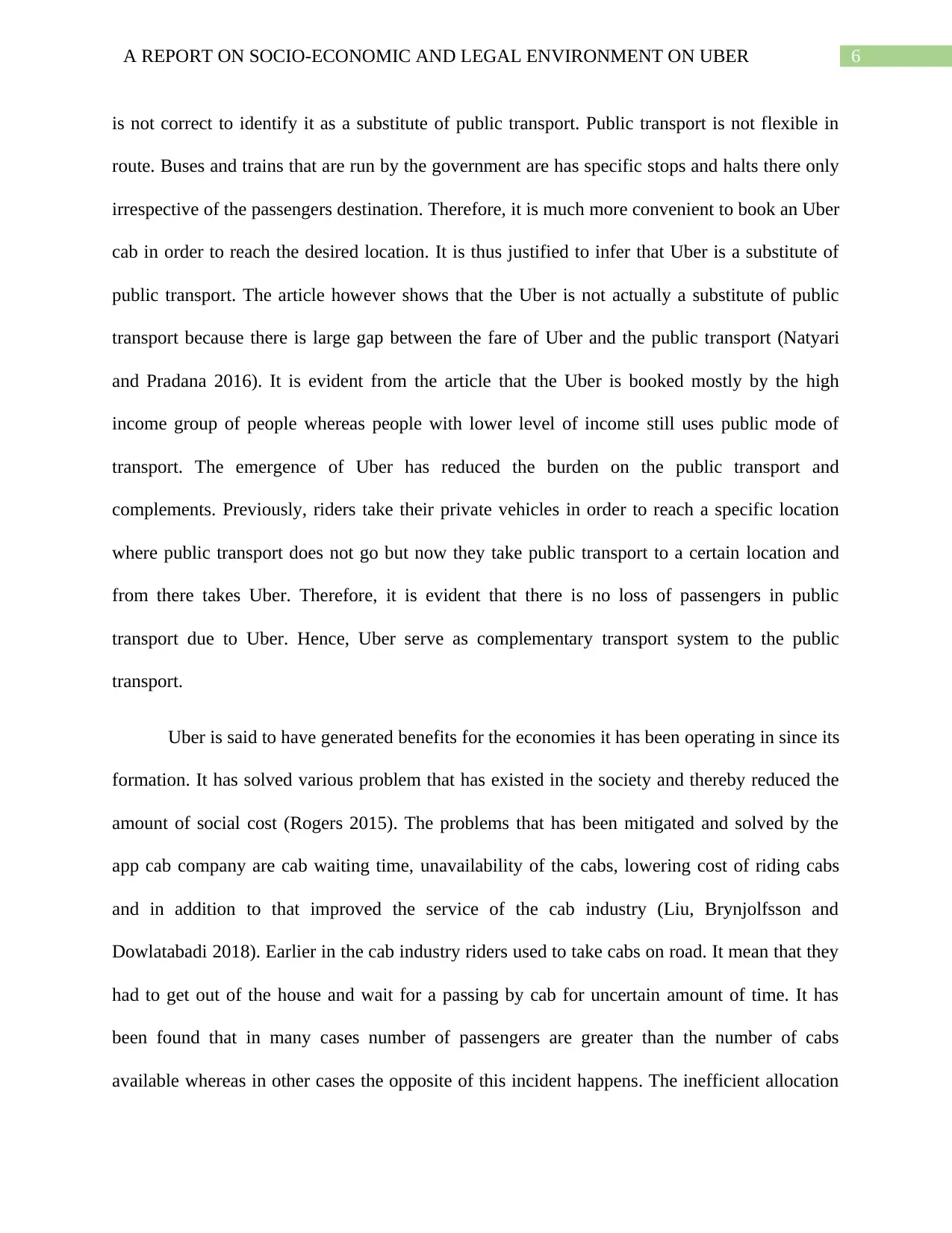
6A REPORT ON SOCIO-ECONOMIC AND LEGAL ENVIRONMENT ON UBER
is not correct to identify it as a substitute of public transport. Public transport is not flexible in
route. Buses and trains that are run by the government are has specific stops and halts there only
irrespective of the passengers destination. Therefore, it is much more convenient to book an Uber
cab in order to reach the desired location. It is thus justified to infer that Uber is a substitute of
public transport. The article however shows that the Uber is not actually a substitute of public
transport because there is large gap between the fare of Uber and the public transport (Natyari
and Pradana 2016). It is evident from the article that the Uber is booked mostly by the high
income group of people whereas people with lower level of income still uses public mode of
transport. The emergence of Uber has reduced the burden on the public transport and
complements. Previously, riders take their private vehicles in order to reach a specific location
where public transport does not go but now they take public transport to a certain location and
from there takes Uber. Therefore, it is evident that there is no loss of passengers in public
transport due to Uber. Hence, Uber serve as complementary transport system to the public
transport.
Uber is said to have generated benefits for the economies it has been operating in since its
formation. It has solved various problem that has existed in the society and thereby reduced the
amount of social cost (Rogers 2015). The problems that has been mitigated and solved by the
app cab company are cab waiting time, unavailability of the cabs, lowering cost of riding cabs
and in addition to that improved the service of the cab industry (Liu, Brynjolfsson and
Dowlatabadi 2018). Earlier in the cab industry riders used to take cabs on road. It mean that they
had to get out of the house and wait for a passing by cab for uncertain amount of time. It has
been found that in many cases number of passengers are greater than the number of cabs
available whereas in other cases the opposite of this incident happens. The inefficient allocation
is not correct to identify it as a substitute of public transport. Public transport is not flexible in
route. Buses and trains that are run by the government are has specific stops and halts there only
irrespective of the passengers destination. Therefore, it is much more convenient to book an Uber
cab in order to reach the desired location. It is thus justified to infer that Uber is a substitute of
public transport. The article however shows that the Uber is not actually a substitute of public
transport because there is large gap between the fare of Uber and the public transport (Natyari
and Pradana 2016). It is evident from the article that the Uber is booked mostly by the high
income group of people whereas people with lower level of income still uses public mode of
transport. The emergence of Uber has reduced the burden on the public transport and
complements. Previously, riders take their private vehicles in order to reach a specific location
where public transport does not go but now they take public transport to a certain location and
from there takes Uber. Therefore, it is evident that there is no loss of passengers in public
transport due to Uber. Hence, Uber serve as complementary transport system to the public
transport.
Uber is said to have generated benefits for the economies it has been operating in since its
formation. It has solved various problem that has existed in the society and thereby reduced the
amount of social cost (Rogers 2015). The problems that has been mitigated and solved by the
app cab company are cab waiting time, unavailability of the cabs, lowering cost of riding cabs
and in addition to that improved the service of the cab industry (Liu, Brynjolfsson and
Dowlatabadi 2018). Earlier in the cab industry riders used to take cabs on road. It mean that they
had to get out of the house and wait for a passing by cab for uncertain amount of time. It has
been found that in many cases number of passengers are greater than the number of cabs
available whereas in other cases the opposite of this incident happens. The inefficient allocation
⊘ This is a preview!⊘
Do you want full access?
Subscribe today to unlock all pages.

Trusted by 1+ million students worldwide
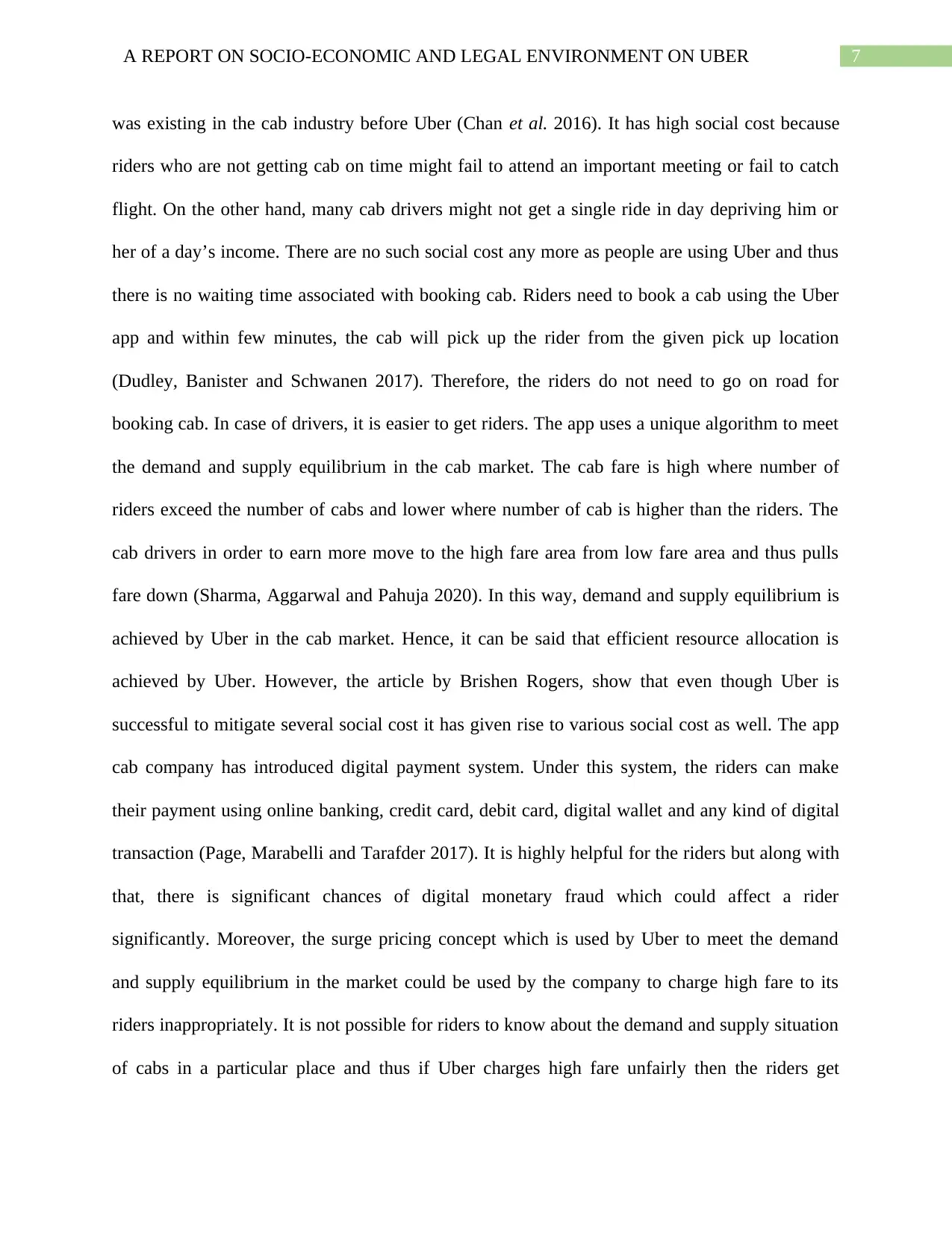
7A REPORT ON SOCIO-ECONOMIC AND LEGAL ENVIRONMENT ON UBER
was existing in the cab industry before Uber (Chan et al. 2016). It has high social cost because
riders who are not getting cab on time might fail to attend an important meeting or fail to catch
flight. On the other hand, many cab drivers might not get a single ride in day depriving him or
her of a day’s income. There are no such social cost any more as people are using Uber and thus
there is no waiting time associated with booking cab. Riders need to book a cab using the Uber
app and within few minutes, the cab will pick up the rider from the given pick up location
(Dudley, Banister and Schwanen 2017). Therefore, the riders do not need to go on road for
booking cab. In case of drivers, it is easier to get riders. The app uses a unique algorithm to meet
the demand and supply equilibrium in the cab market. The cab fare is high where number of
riders exceed the number of cabs and lower where number of cab is higher than the riders. The
cab drivers in order to earn more move to the high fare area from low fare area and thus pulls
fare down (Sharma, Aggarwal and Pahuja 2020). In this way, demand and supply equilibrium is
achieved by Uber in the cab market. Hence, it can be said that efficient resource allocation is
achieved by Uber. However, the article by Brishen Rogers, show that even though Uber is
successful to mitigate several social cost it has given rise to various social cost as well. The app
cab company has introduced digital payment system. Under this system, the riders can make
their payment using online banking, credit card, debit card, digital wallet and any kind of digital
transaction (Page, Marabelli and Tarafder 2017). It is highly helpful for the riders but along with
that, there is significant chances of digital monetary fraud which could affect a rider
significantly. Moreover, the surge pricing concept which is used by Uber to meet the demand
and supply equilibrium in the market could be used by the company to charge high fare to its
riders inappropriately. It is not possible for riders to know about the demand and supply situation
of cabs in a particular place and thus if Uber charges high fare unfairly then the riders get
was existing in the cab industry before Uber (Chan et al. 2016). It has high social cost because
riders who are not getting cab on time might fail to attend an important meeting or fail to catch
flight. On the other hand, many cab drivers might not get a single ride in day depriving him or
her of a day’s income. There are no such social cost any more as people are using Uber and thus
there is no waiting time associated with booking cab. Riders need to book a cab using the Uber
app and within few minutes, the cab will pick up the rider from the given pick up location
(Dudley, Banister and Schwanen 2017). Therefore, the riders do not need to go on road for
booking cab. In case of drivers, it is easier to get riders. The app uses a unique algorithm to meet
the demand and supply equilibrium in the cab market. The cab fare is high where number of
riders exceed the number of cabs and lower where number of cab is higher than the riders. The
cab drivers in order to earn more move to the high fare area from low fare area and thus pulls
fare down (Sharma, Aggarwal and Pahuja 2020). In this way, demand and supply equilibrium is
achieved by Uber in the cab market. Hence, it can be said that efficient resource allocation is
achieved by Uber. However, the article by Brishen Rogers, show that even though Uber is
successful to mitigate several social cost it has given rise to various social cost as well. The app
cab company has introduced digital payment system. Under this system, the riders can make
their payment using online banking, credit card, debit card, digital wallet and any kind of digital
transaction (Page, Marabelli and Tarafder 2017). It is highly helpful for the riders but along with
that, there is significant chances of digital monetary fraud which could affect a rider
significantly. Moreover, the surge pricing concept which is used by Uber to meet the demand
and supply equilibrium in the market could be used by the company to charge high fare to its
riders inappropriately. It is not possible for riders to know about the demand and supply situation
of cabs in a particular place and thus if Uber charges high fare unfairly then the riders get
Paraphrase This Document
Need a fresh take? Get an instant paraphrase of this document with our AI Paraphraser
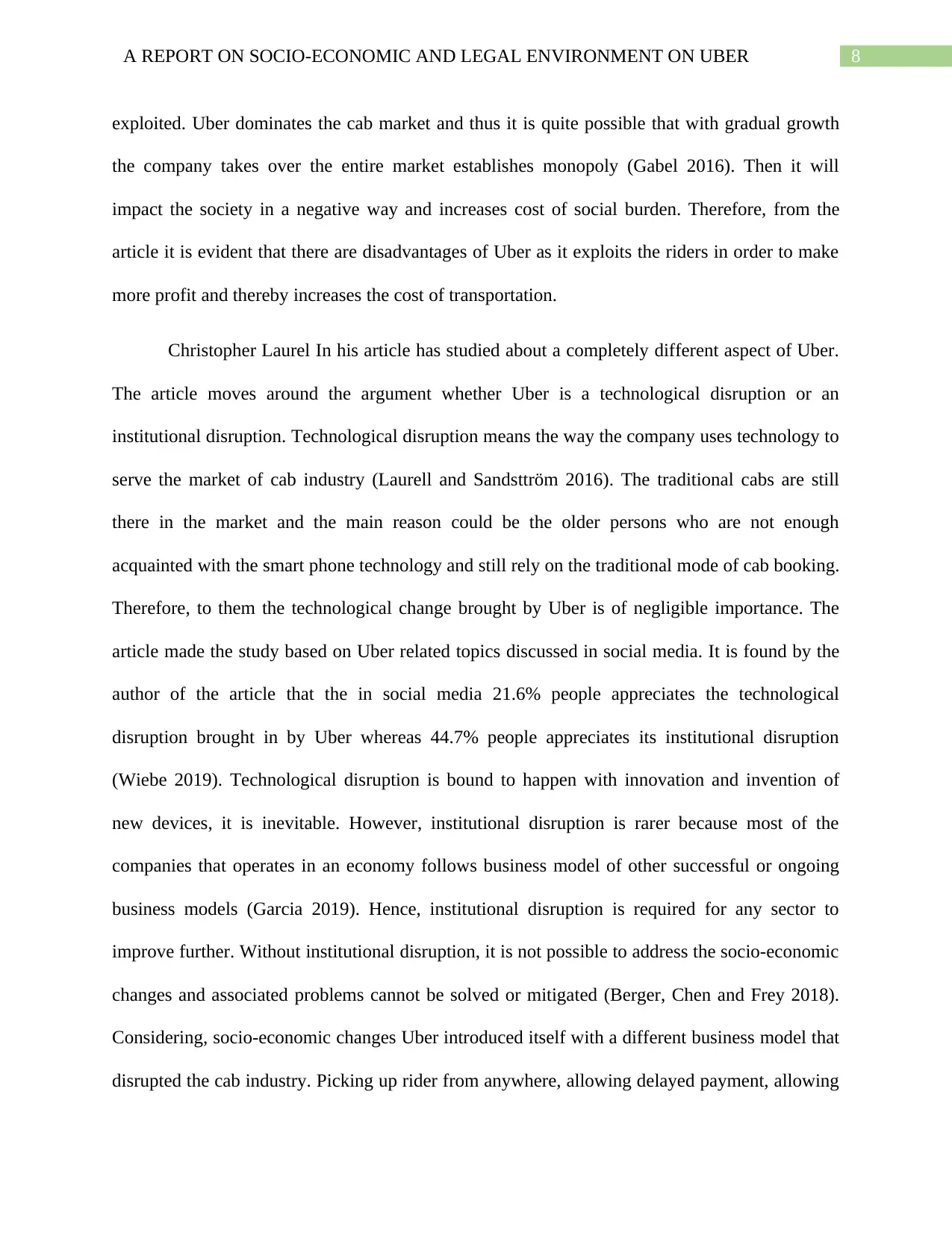
8A REPORT ON SOCIO-ECONOMIC AND LEGAL ENVIRONMENT ON UBER
exploited. Uber dominates the cab market and thus it is quite possible that with gradual growth
the company takes over the entire market establishes monopoly (Gabel 2016). Then it will
impact the society in a negative way and increases cost of social burden. Therefore, from the
article it is evident that there are disadvantages of Uber as it exploits the riders in order to make
more profit and thereby increases the cost of transportation.
Christopher Laurel In his article has studied about a completely different aspect of Uber.
The article moves around the argument whether Uber is a technological disruption or an
institutional disruption. Technological disruption means the way the company uses technology to
serve the market of cab industry (Laurell and Sandsttröm 2016). The traditional cabs are still
there in the market and the main reason could be the older persons who are not enough
acquainted with the smart phone technology and still rely on the traditional mode of cab booking.
Therefore, to them the technological change brought by Uber is of negligible importance. The
article made the study based on Uber related topics discussed in social media. It is found by the
author of the article that the in social media 21.6% people appreciates the technological
disruption brought in by Uber whereas 44.7% people appreciates its institutional disruption
(Wiebe 2019). Technological disruption is bound to happen with innovation and invention of
new devices, it is inevitable. However, institutional disruption is rarer because most of the
companies that operates in an economy follows business model of other successful or ongoing
business models (Garcia 2019). Hence, institutional disruption is required for any sector to
improve further. Without institutional disruption, it is not possible to address the socio-economic
changes and associated problems cannot be solved or mitigated (Berger, Chen and Frey 2018).
Considering, socio-economic changes Uber introduced itself with a different business model that
disrupted the cab industry. Picking up rider from anywhere, allowing delayed payment, allowing
exploited. Uber dominates the cab market and thus it is quite possible that with gradual growth
the company takes over the entire market establishes monopoly (Gabel 2016). Then it will
impact the society in a negative way and increases cost of social burden. Therefore, from the
article it is evident that there are disadvantages of Uber as it exploits the riders in order to make
more profit and thereby increases the cost of transportation.
Christopher Laurel In his article has studied about a completely different aspect of Uber.
The article moves around the argument whether Uber is a technological disruption or an
institutional disruption. Technological disruption means the way the company uses technology to
serve the market of cab industry (Laurell and Sandsttröm 2016). The traditional cabs are still
there in the market and the main reason could be the older persons who are not enough
acquainted with the smart phone technology and still rely on the traditional mode of cab booking.
Therefore, to them the technological change brought by Uber is of negligible importance. The
article made the study based on Uber related topics discussed in social media. It is found by the
author of the article that the in social media 21.6% people appreciates the technological
disruption brought in by Uber whereas 44.7% people appreciates its institutional disruption
(Wiebe 2019). Technological disruption is bound to happen with innovation and invention of
new devices, it is inevitable. However, institutional disruption is rarer because most of the
companies that operates in an economy follows business model of other successful or ongoing
business models (Garcia 2019). Hence, institutional disruption is required for any sector to
improve further. Without institutional disruption, it is not possible to address the socio-economic
changes and associated problems cannot be solved or mitigated (Berger, Chen and Frey 2018).
Considering, socio-economic changes Uber introduced itself with a different business model that
disrupted the cab industry. Picking up rider from anywhere, allowing delayed payment, allowing
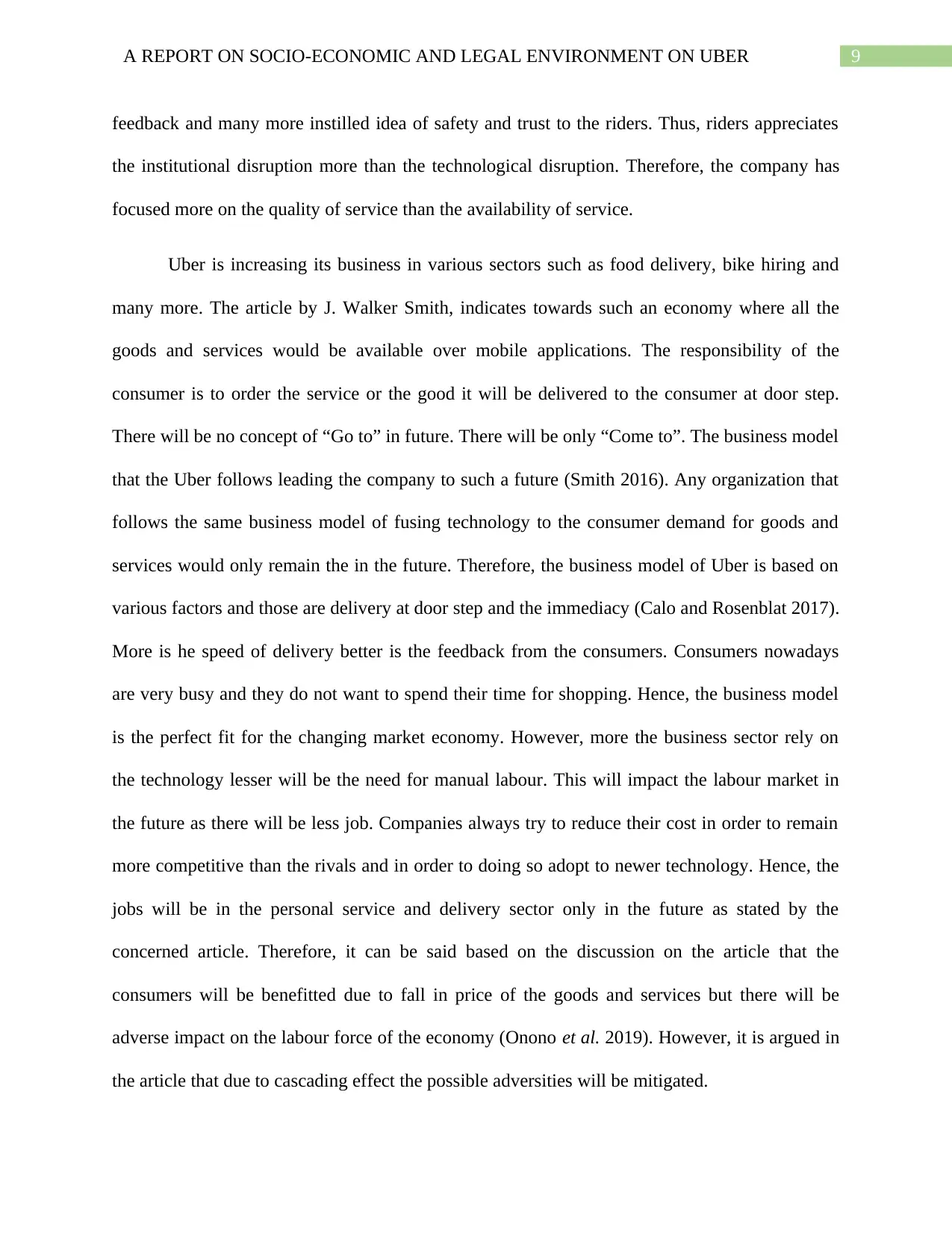
9A REPORT ON SOCIO-ECONOMIC AND LEGAL ENVIRONMENT ON UBER
feedback and many more instilled idea of safety and trust to the riders. Thus, riders appreciates
the institutional disruption more than the technological disruption. Therefore, the company has
focused more on the quality of service than the availability of service.
Uber is increasing its business in various sectors such as food delivery, bike hiring and
many more. The article by J. Walker Smith, indicates towards such an economy where all the
goods and services would be available over mobile applications. The responsibility of the
consumer is to order the service or the good it will be delivered to the consumer at door step.
There will be no concept of “Go to” in future. There will be only “Come to”. The business model
that the Uber follows leading the company to such a future (Smith 2016). Any organization that
follows the same business model of fusing technology to the consumer demand for goods and
services would only remain the in the future. Therefore, the business model of Uber is based on
various factors and those are delivery at door step and the immediacy (Calo and Rosenblat 2017).
More is he speed of delivery better is the feedback from the consumers. Consumers nowadays
are very busy and they do not want to spend their time for shopping. Hence, the business model
is the perfect fit for the changing market economy. However, more the business sector rely on
the technology lesser will be the need for manual labour. This will impact the labour market in
the future as there will be less job. Companies always try to reduce their cost in order to remain
more competitive than the rivals and in order to doing so adopt to newer technology. Hence, the
jobs will be in the personal service and delivery sector only in the future as stated by the
concerned article. Therefore, it can be said based on the discussion on the article that the
consumers will be benefitted due to fall in price of the goods and services but there will be
adverse impact on the labour force of the economy (Onono et al. 2019). However, it is argued in
the article that due to cascading effect the possible adversities will be mitigated.
feedback and many more instilled idea of safety and trust to the riders. Thus, riders appreciates
the institutional disruption more than the technological disruption. Therefore, the company has
focused more on the quality of service than the availability of service.
Uber is increasing its business in various sectors such as food delivery, bike hiring and
many more. The article by J. Walker Smith, indicates towards such an economy where all the
goods and services would be available over mobile applications. The responsibility of the
consumer is to order the service or the good it will be delivered to the consumer at door step.
There will be no concept of “Go to” in future. There will be only “Come to”. The business model
that the Uber follows leading the company to such a future (Smith 2016). Any organization that
follows the same business model of fusing technology to the consumer demand for goods and
services would only remain the in the future. Therefore, the business model of Uber is based on
various factors and those are delivery at door step and the immediacy (Calo and Rosenblat 2017).
More is he speed of delivery better is the feedback from the consumers. Consumers nowadays
are very busy and they do not want to spend their time for shopping. Hence, the business model
is the perfect fit for the changing market economy. However, more the business sector rely on
the technology lesser will be the need for manual labour. This will impact the labour market in
the future as there will be less job. Companies always try to reduce their cost in order to remain
more competitive than the rivals and in order to doing so adopt to newer technology. Hence, the
jobs will be in the personal service and delivery sector only in the future as stated by the
concerned article. Therefore, it can be said based on the discussion on the article that the
consumers will be benefitted due to fall in price of the goods and services but there will be
adverse impact on the labour force of the economy (Onono et al. 2019). However, it is argued in
the article that due to cascading effect the possible adversities will be mitigated.
⊘ This is a preview!⊘
Do you want full access?
Subscribe today to unlock all pages.

Trusted by 1+ million students worldwide
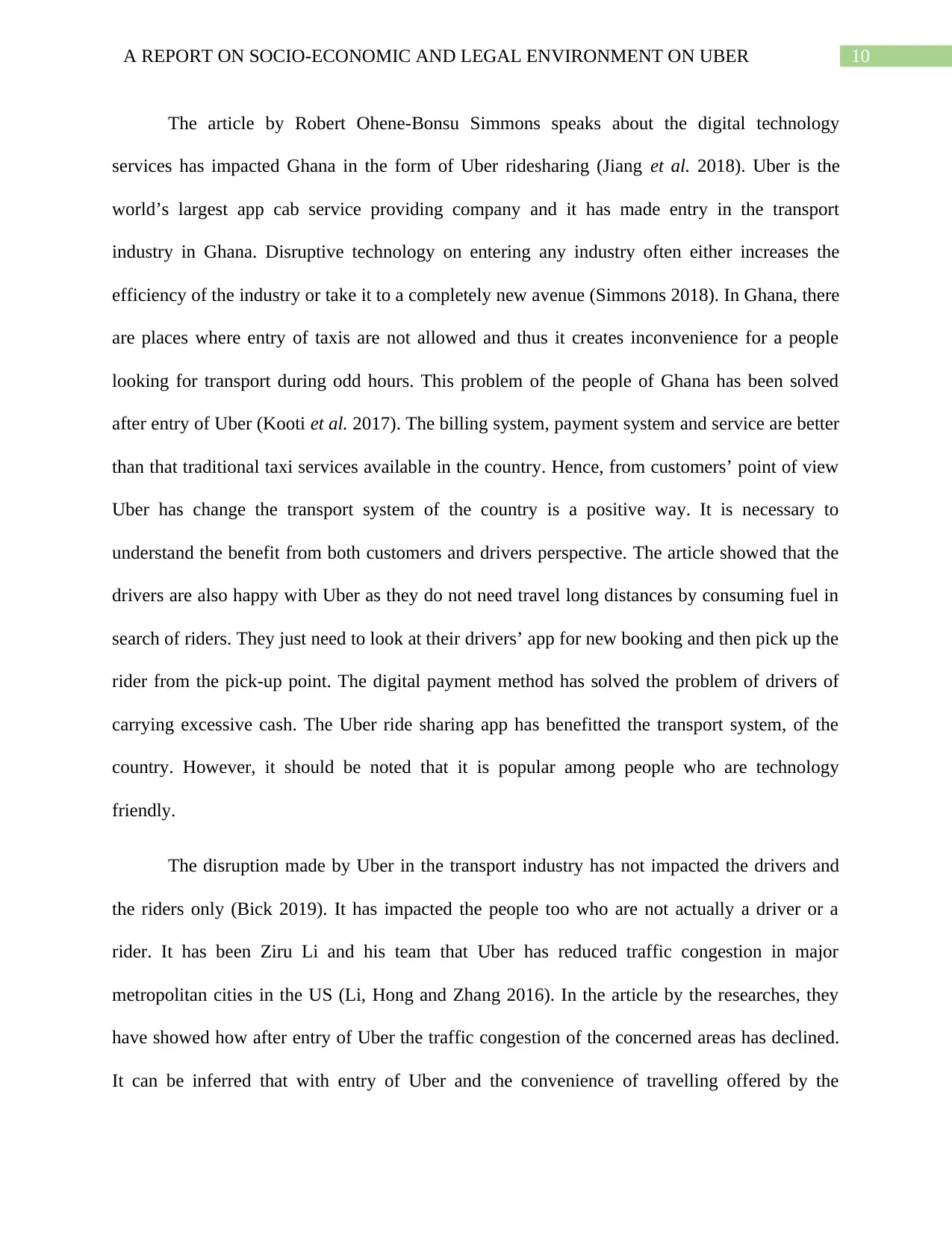
10A REPORT ON SOCIO-ECONOMIC AND LEGAL ENVIRONMENT ON UBER
The article by Robert Ohene-Bonsu Simmons speaks about the digital technology
services has impacted Ghana in the form of Uber ridesharing (Jiang et al. 2018). Uber is the
world’s largest app cab service providing company and it has made entry in the transport
industry in Ghana. Disruptive technology on entering any industry often either increases the
efficiency of the industry or take it to a completely new avenue (Simmons 2018). In Ghana, there
are places where entry of taxis are not allowed and thus it creates inconvenience for a people
looking for transport during odd hours. This problem of the people of Ghana has been solved
after entry of Uber (Kooti et al. 2017). The billing system, payment system and service are better
than that traditional taxi services available in the country. Hence, from customers’ point of view
Uber has change the transport system of the country is a positive way. It is necessary to
understand the benefit from both customers and drivers perspective. The article showed that the
drivers are also happy with Uber as they do not need travel long distances by consuming fuel in
search of riders. They just need to look at their drivers’ app for new booking and then pick up the
rider from the pick-up point. The digital payment method has solved the problem of drivers of
carrying excessive cash. The Uber ride sharing app has benefitted the transport system, of the
country. However, it should be noted that it is popular among people who are technology
friendly.
The disruption made by Uber in the transport industry has not impacted the drivers and
the riders only (Bick 2019). It has impacted the people too who are not actually a driver or a
rider. It has been Ziru Li and his team that Uber has reduced traffic congestion in major
metropolitan cities in the US (Li, Hong and Zhang 2016). In the article by the researches, they
have showed how after entry of Uber the traffic congestion of the concerned areas has declined.
It can be inferred that with entry of Uber and the convenience of travelling offered by the
The article by Robert Ohene-Bonsu Simmons speaks about the digital technology
services has impacted Ghana in the form of Uber ridesharing (Jiang et al. 2018). Uber is the
world’s largest app cab service providing company and it has made entry in the transport
industry in Ghana. Disruptive technology on entering any industry often either increases the
efficiency of the industry or take it to a completely new avenue (Simmons 2018). In Ghana, there
are places where entry of taxis are not allowed and thus it creates inconvenience for a people
looking for transport during odd hours. This problem of the people of Ghana has been solved
after entry of Uber (Kooti et al. 2017). The billing system, payment system and service are better
than that traditional taxi services available in the country. Hence, from customers’ point of view
Uber has change the transport system of the country is a positive way. It is necessary to
understand the benefit from both customers and drivers perspective. The article showed that the
drivers are also happy with Uber as they do not need travel long distances by consuming fuel in
search of riders. They just need to look at their drivers’ app for new booking and then pick up the
rider from the pick-up point. The digital payment method has solved the problem of drivers of
carrying excessive cash. The Uber ride sharing app has benefitted the transport system, of the
country. However, it should be noted that it is popular among people who are technology
friendly.
The disruption made by Uber in the transport industry has not impacted the drivers and
the riders only (Bick 2019). It has impacted the people too who are not actually a driver or a
rider. It has been Ziru Li and his team that Uber has reduced traffic congestion in major
metropolitan cities in the US (Li, Hong and Zhang 2016). In the article by the researches, they
have showed how after entry of Uber the traffic congestion of the concerned areas has declined.
It can be inferred that with entry of Uber and the convenience of travelling offered by the
Paraphrase This Document
Need a fresh take? Get an instant paraphrase of this document with our AI Paraphraser
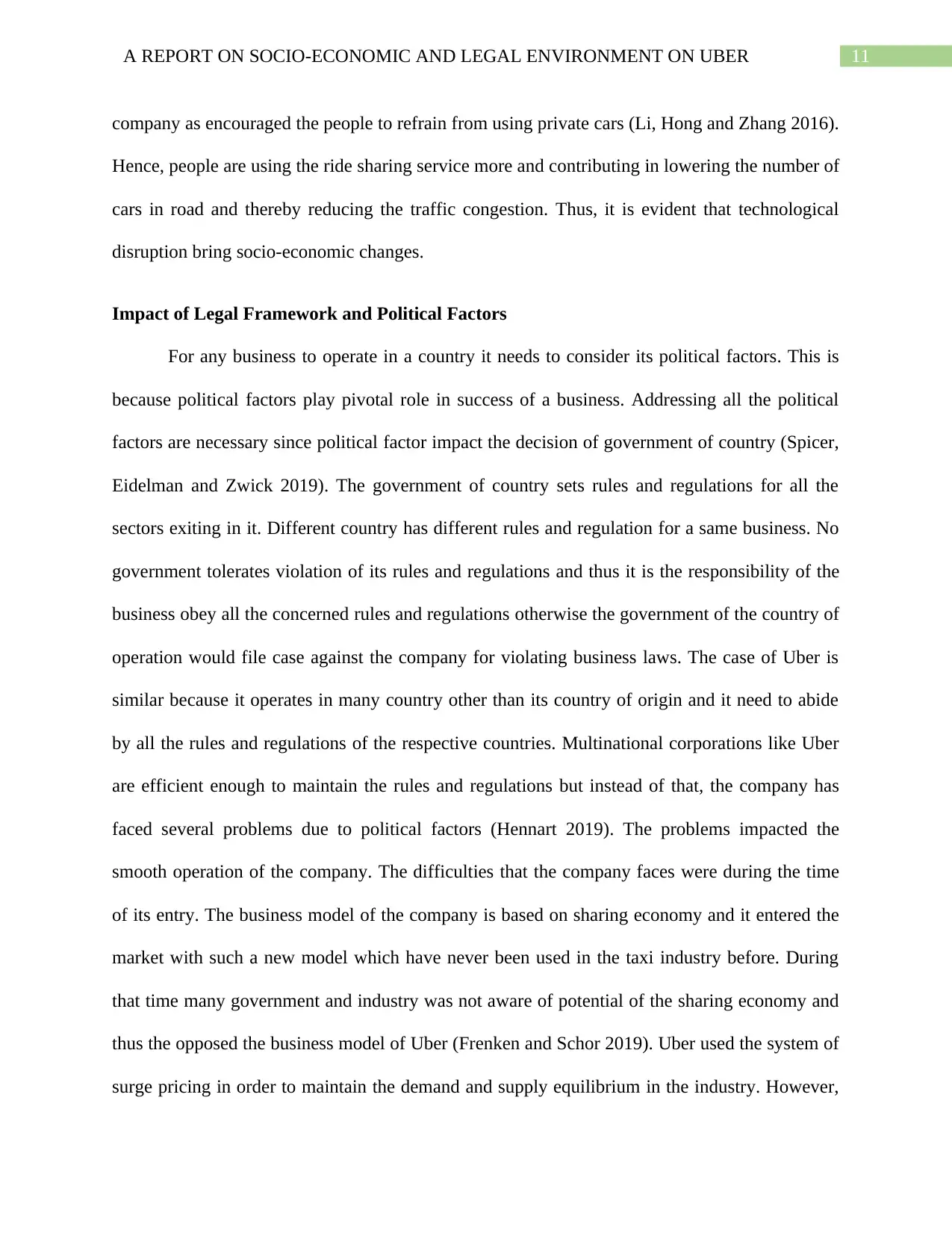
11A REPORT ON SOCIO-ECONOMIC AND LEGAL ENVIRONMENT ON UBER
company as encouraged the people to refrain from using private cars (Li, Hong and Zhang 2016).
Hence, people are using the ride sharing service more and contributing in lowering the number of
cars in road and thereby reducing the traffic congestion. Thus, it is evident that technological
disruption bring socio-economic changes.
Impact of Legal Framework and Political Factors
For any business to operate in a country it needs to consider its political factors. This is
because political factors play pivotal role in success of a business. Addressing all the political
factors are necessary since political factor impact the decision of government of country (Spicer,
Eidelman and Zwick 2019). The government of country sets rules and regulations for all the
sectors exiting in it. Different country has different rules and regulation for a same business. No
government tolerates violation of its rules and regulations and thus it is the responsibility of the
business obey all the concerned rules and regulations otherwise the government of the country of
operation would file case against the company for violating business laws. The case of Uber is
similar because it operates in many country other than its country of origin and it need to abide
by all the rules and regulations of the respective countries. Multinational corporations like Uber
are efficient enough to maintain the rules and regulations but instead of that, the company has
faced several problems due to political factors (Hennart 2019). The problems impacted the
smooth operation of the company. The difficulties that the company faces were during the time
of its entry. The business model of the company is based on sharing economy and it entered the
market with such a new model which have never been used in the taxi industry before. During
that time many government and industry was not aware of potential of the sharing economy and
thus the opposed the business model of Uber (Frenken and Schor 2019). Uber used the system of
surge pricing in order to maintain the demand and supply equilibrium in the industry. However,
company as encouraged the people to refrain from using private cars (Li, Hong and Zhang 2016).
Hence, people are using the ride sharing service more and contributing in lowering the number of
cars in road and thereby reducing the traffic congestion. Thus, it is evident that technological
disruption bring socio-economic changes.
Impact of Legal Framework and Political Factors
For any business to operate in a country it needs to consider its political factors. This is
because political factors play pivotal role in success of a business. Addressing all the political
factors are necessary since political factor impact the decision of government of country (Spicer,
Eidelman and Zwick 2019). The government of country sets rules and regulations for all the
sectors exiting in it. Different country has different rules and regulation for a same business. No
government tolerates violation of its rules and regulations and thus it is the responsibility of the
business obey all the concerned rules and regulations otherwise the government of the country of
operation would file case against the company for violating business laws. The case of Uber is
similar because it operates in many country other than its country of origin and it need to abide
by all the rules and regulations of the respective countries. Multinational corporations like Uber
are efficient enough to maintain the rules and regulations but instead of that, the company has
faced several problems due to political factors (Hennart 2019). The problems impacted the
smooth operation of the company. The difficulties that the company faces were during the time
of its entry. The business model of the company is based on sharing economy and it entered the
market with such a new model which have never been used in the taxi industry before. During
that time many government and industry was not aware of potential of the sharing economy and
thus the opposed the business model of Uber (Frenken and Schor 2019). Uber used the system of
surge pricing in order to maintain the demand and supply equilibrium in the industry. However,
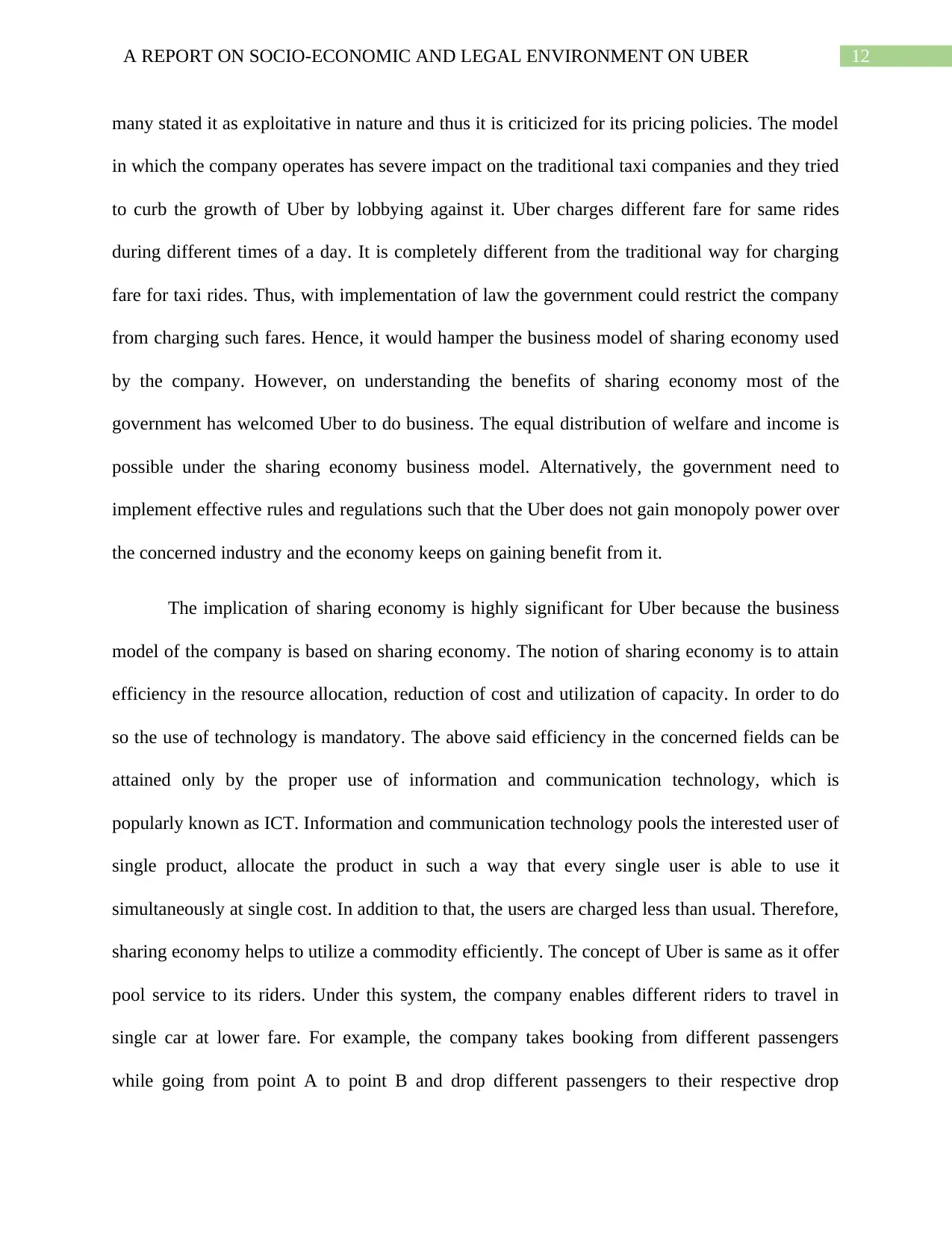
12A REPORT ON SOCIO-ECONOMIC AND LEGAL ENVIRONMENT ON UBER
many stated it as exploitative in nature and thus it is criticized for its pricing policies. The model
in which the company operates has severe impact on the traditional taxi companies and they tried
to curb the growth of Uber by lobbying against it. Uber charges different fare for same rides
during different times of a day. It is completely different from the traditional way for charging
fare for taxi rides. Thus, with implementation of law the government could restrict the company
from charging such fares. Hence, it would hamper the business model of sharing economy used
by the company. However, on understanding the benefits of sharing economy most of the
government has welcomed Uber to do business. The equal distribution of welfare and income is
possible under the sharing economy business model. Alternatively, the government need to
implement effective rules and regulations such that the Uber does not gain monopoly power over
the concerned industry and the economy keeps on gaining benefit from it.
The implication of sharing economy is highly significant for Uber because the business
model of the company is based on sharing economy. The notion of sharing economy is to attain
efficiency in the resource allocation, reduction of cost and utilization of capacity. In order to do
so the use of technology is mandatory. The above said efficiency in the concerned fields can be
attained only by the proper use of information and communication technology, which is
popularly known as ICT. Information and communication technology pools the interested user of
single product, allocate the product in such a way that every single user is able to use it
simultaneously at single cost. In addition to that, the users are charged less than usual. Therefore,
sharing economy helps to utilize a commodity efficiently. The concept of Uber is same as it offer
pool service to its riders. Under this system, the company enables different riders to travel in
single car at lower fare. For example, the company takes booking from different passengers
while going from point A to point B and drop different passengers to their respective drop
many stated it as exploitative in nature and thus it is criticized for its pricing policies. The model
in which the company operates has severe impact on the traditional taxi companies and they tried
to curb the growth of Uber by lobbying against it. Uber charges different fare for same rides
during different times of a day. It is completely different from the traditional way for charging
fare for taxi rides. Thus, with implementation of law the government could restrict the company
from charging such fares. Hence, it would hamper the business model of sharing economy used
by the company. However, on understanding the benefits of sharing economy most of the
government has welcomed Uber to do business. The equal distribution of welfare and income is
possible under the sharing economy business model. Alternatively, the government need to
implement effective rules and regulations such that the Uber does not gain monopoly power over
the concerned industry and the economy keeps on gaining benefit from it.
The implication of sharing economy is highly significant for Uber because the business
model of the company is based on sharing economy. The notion of sharing economy is to attain
efficiency in the resource allocation, reduction of cost and utilization of capacity. In order to do
so the use of technology is mandatory. The above said efficiency in the concerned fields can be
attained only by the proper use of information and communication technology, which is
popularly known as ICT. Information and communication technology pools the interested user of
single product, allocate the product in such a way that every single user is able to use it
simultaneously at single cost. In addition to that, the users are charged less than usual. Therefore,
sharing economy helps to utilize a commodity efficiently. The concept of Uber is same as it offer
pool service to its riders. Under this system, the company enables different riders to travel in
single car at lower fare. For example, the company takes booking from different passengers
while going from point A to point B and drop different passengers to their respective drop
⊘ This is a preview!⊘
Do you want full access?
Subscribe today to unlock all pages.

Trusted by 1+ million students worldwide
1 out of 19
Related Documents
Your All-in-One AI-Powered Toolkit for Academic Success.
+13062052269
info@desklib.com
Available 24*7 on WhatsApp / Email
![[object Object]](/_next/static/media/star-bottom.7253800d.svg)
Unlock your academic potential
Copyright © 2020–2025 A2Z Services. All Rights Reserved. Developed and managed by ZUCOL.





